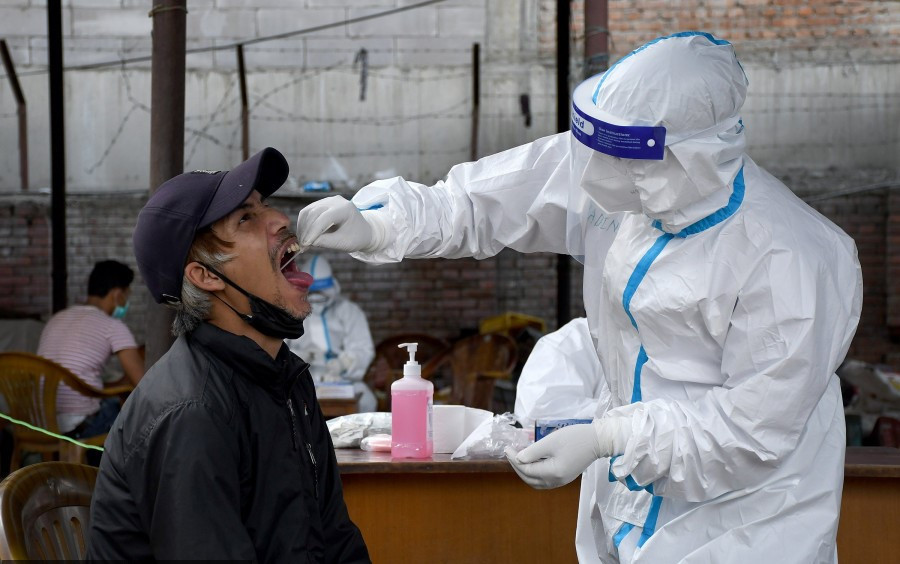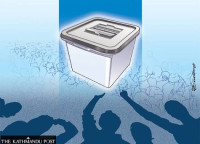Columns
Breakthrough Covid-19 wave in Nepal
It is difficult to predict the outcome of the current breakthrough. Careful monitoring is essential.
Dr Sher Bahadur Pun
There has been a gradual rise in the number of breakthrough Covid-19 cases across Nepal for the first time in several months. According to the United States Centres for Disease Control and Prevention (CDC), a vaccine breakthrough infection/case is defined as the detection of SARS-CoV-2 RNA or antigen in a respiratory specimen collected from a person more than 14 days after receipt of all recommended doses of an FDA-authorised Covid-19 vaccine. For a couple of days, I have been treating and advising several patients who tested positive for SARS-CoV-2 and have received their three recommended doses (including the first booster dose). This means that for the first time, large breakthrough Covid-19 wave is being observed/will likely be experienced further in the coming days in Nepal.
As per the Ministry of Health and Population, as of February 21, 2023, 76.5 percent of the population received at least two recommended doses (full dose) of the government’s authorised Covid-19 vaccine. That is 95.7 percent of the target population (i.e., aged 12 years or above).
Symptoms of Covid-19 have changed over time, perhaps due to vaccinations, immunity from prior infections, or as a result of mutation/hybridisation between two or more sub-variants/lineages. During the first wave (probably the Wuhan virus strain, but not announced officially), the majority of patients who were infected with SARS-CoV-2 mainly presented with fever, cough and shortness of breath. The second wave, known as “Delta”, was regarded as the most devastating among the three waves, and hundreds of thousands died of Covid-19 complications. I refer to this variant as an “oxygen variant” because most patients died due to a lack of oxygen therapy.
Surprisingly, the third wave was comparatively less severe than previous Covid-19 waves and showed symptoms similar to the common cold. A new “Omicron” variant had triggered this wave. Genome sequencing done at the end of 2022 showed that at least 17 sub-variants of Omicron were circulating in Nepal. Since then, however, no information has been available about the variants/sub-variants of SARS-CoV-2. Hence, at present, there are only speculations about the variants/sub-variants responsible for the ongoing surge of Covid-19 cases in Nepal.
There are several possible explanations for the ongoing Covid-19 wave in Nepal. First, a new hybrid sub-lineage of the Omicron variant known as “XBB.1.16” has already been introduced, is spreading, and may be associated with the current surge of the SARS-CoV-2 outbreak in Nepal. The “XBB.1.16” virus is a hybrid form of two different sub-lineages of Omicron variant “BA.2.10.1 and BA.2.75” and was first described in late January 2023 in India. This new virus is categorised as the “variant under monitoring” by the World Health Organization (WHO). The new variant must have entered Nepal from India as a result of people moving between the two countries due to open borders and a lack of adequate screening (SARS-CoV-2) facilities. In the past, Nepal has experienced/observed several Covid-19 waves after the virus wreaked havoc in India.
Second, any new SARS-CoV-2 virus can emerge or develop anywhere globally at any time. A new virus can emerge when two or more viruses combine, or after mutations occur. Thus, genome sequencing reported in late 2022 showed that at least 17 sub-variants of the Omicron variant have been circulating in Nepal, meaning there is a greater possibility of developing a new virus after hybridisation among these Omicron sub-variants and or mutations. Third, any new virus from third countries can also be introduced through the Tribhuvan International Airport. Nepal has already relaxed Covid-19-related international travel restrictions imposed during the Covid-19 waves.
The most striking observation during the treatment/counselling was “a return of symptoms such as loss of taste and smell”. Prior to the introduction of the Omicron variant, loss of taste and smell were considered the main symptoms of Covid-19 and even helpful in assuming infection. However, since the introduction of the Omicron variant, symptoms have changed, showing symptoms similar to common cold. In Nepal, throat pain/irritation, severe fatigue, head/body pain, low-grade fever, and running nose were found to be the most common symptoms during the Omicron wave. However, the loss of taste and smell was found not as common as compared to previous variants. Dengue-like illness such as severe headache, pain behind the eyes and chills (but without high-grade fever), and lower back pain are other unexpected symptoms presented by Covid-19 patients. According to Indian doctors, signs and symptoms of the new sub-variant “XBB.1.16” are very similar to that of original Omicron variant. The reasons for the variation in symptoms between Indian and Nepali Covid-19 patients can be a matter for investigation or further study.
Currently, two viruses, influenza and SARS-CoV-2 (sometimes referred to as “twindemic”), are co-circulating in Nepal. People with fever, cough, running nose and bodyache believe they are suffering from the flu virus and are not testing SARS-CoV-2 virus. It means the number of Covid-19 infections in the community might be much higher than the official figures, and careful monitoring from the concerned body is essential.
A possible outcome of the current breakthrough Covid-19 wave may not be predicted easily. Nevertheless, the world, particularly the scientific community, are keen to know and understand the impact of Covid-19 disease, particularly the duration of effectiveness of vaccines and the impact of the vaccines against ongoing new mutated/hybrid SARS-CoV-2 virus, because it has already been more than six months since the completion of the primary series, including booster dose/s.




 10.12°C Kathmandu
10.12°C Kathmandu















